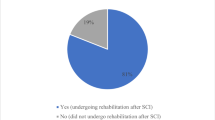Abstract
There is considerable evidence that management in a specialist unit is beneficial both for the individual patient and for the economy. A specialised unit provides a focus for a campaign for prevention, for the improvement in care in areas such as orthopaedic, bladder, bowel, skin, etc and for the promotion of interdisciplinary work, combining the needs of public health, low-cost technology, and high quality. Strategy and training is dictated by the specific problems that occur in patients with spinal injuries, particularly the multisystem impairment, which is a feature of such injuries and can only be comprehensively dealt with in a specialised unit. For developing countries, training may be either on-site or in centres abroad, or a combination of both, and rather than training on an individual basis, it is preferable for a team to be trained together. The likely cost depends on local circumstances. However, even the cost of a purpose-built centre of 44 beds serving 3000 paralysed people in the UK is only the equivalent of the lifetime costs of about 12 people with SCI.
Similar content being viewed by others
Log in or create a free account to read this content
Gain free access to this article, as well as selected content from this journal and more on nature.com
or
References
Stover SL, DeLisa JA, Whiteneck GG . Clinical Outcomes from the Model Systems in Spinal Cord Injury. Aspen Publishers: Maryland, USA 1995, pp 234–271.
Ditunno JF, Formal CS . Chronic spinal cord injury. N Engl J Med 1994; 330: 550–556.
Smith M . Efficacy of specialist versus non-specialist management of spinal cord injury within the UK. Spinal Cord 2002; 40: 11–16.
Guidelines Committee. Guidelines for the management of acute cervical spine and spinal cord injuries. Neurosurgery (on line) 2002; 50 (Suppl. 3) (March).
Aung TS, El-Masry WS . Audit of a British centre for spinal injury. Spinal Cord 1997; 35: 147–150.
Acknowledgements
I acknowledge the help and advice, which I received from Mr Waghi El-Masry, Oswestry, Dr A Soopramanien, Salisbury, and Dr J Ditunno, Philadelphia.
Author information
Authors and Affiliations
Additional information
This paper is based on a lecture given in Sri Lanka, February 2003 and a submission to the Sri Lankan Ministry of Health
Rights and permissions
About this article
Cite this article
Illis, L. The case for specialist units. Spinal Cord 42, 443–446 (2004). https://doi.org/10.1038/sj.sc.3101633
Published:
Issue date:
DOI: https://doi.org/10.1038/sj.sc.3101633
Keywords
This article is cited by
-
Utilization of health care providers by individuals with chronic spinal cord injury
Spinal Cord (2021)
-
Medical conditions and outcomes at 1 year after acute traumatic spinal cord injury in a Greek and a Swedish region: a prospective, population-based study
Spinal Cord (2010)
-
Acute management of traumatic spinal cord injury in a Greek and a Swedish region: a prospective, population-based study
Spinal Cord (2010)
-
Utilization, access and satisfaction with primary care among people with spinal cord injuries: a comparison of three countries
Spinal Cord (2007)
-
Epidemiology of spinal cord injuries in the 2005 Pakistan earthquake
Spinal Cord (2007)



